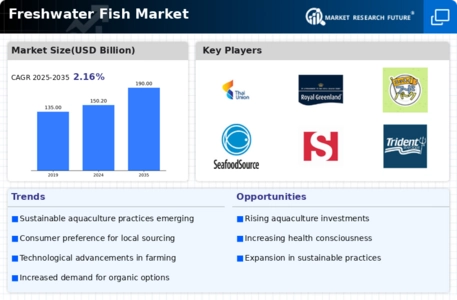-
EXECUTIVE SUMMARY
-
Market Overview
-
Key Findings
-
Market Segmentation
-
Competitive Landscape
-
Challenges and Opportunities
-
Future Outlook
-
MARKET INTRODUCTION
-
Definition
-
Scope of the study
-
Research Objective
-
Assumption
-
Limitations
-
RESEARCH METHODOLOGY
-
Overview
-
Data Mining
-
Secondary Research
-
Primary Research
-
Primary Interviews and Information Gathering Process
-
Breakdown of Primary Respondents
-
Forecasting Model
-
Market Size Estimation
-
Bottom-Up Approach
-
Top-Down Approach
-
Data Triangulation
-
Validation
-
MARKET DYNAMICS
-
Overview
-
Drivers
-
Restraints
-
Opportunities
-
MARKET FACTOR ANALYSIS
-
Value chain Analysis
-
Porter's Five Forces Analysis
-
Bargaining Power of Suppliers
-
Bargaining Power of Buyers
-
Threat of New Entrants
-
Threat of Substitutes
-
Intensity of Rivalry
-
COVID-19 Impact Analysis
-
Market Impact Analysis
-
Regional Impact
-
Opportunity and Threat Analysis
-
Freshwater Fish Market, BY Species (USD Billion)
-
Tilapia
-
Catfish
-
Trout
-
Carp
-
Bass
-
Freshwater Fish Market, BY Sales Channel (USD Billion)
-
Supermarkets
-
Online Retail
-
Fish Markets
-
Wholesale
-
Freshwater Fish Market, BY End Use (USD Billion)
-
Food Service
-
Retail
-
Processing
-
Freshwater Fish Market, BY Form (USD Billion)
-
Live
-
Fresh
-
Frozen
-
Canned
-
Freshwater Fish Market, BY Regional (USD Billion)
-
North America
-
US
-
Canada
-
Europe
-
Germany
-
UK
-
France
-
Russia
-
Italy
-
Spain
-
Rest of Europe
-
APAC
-
China
-
India
-
Japan
-
South Korea
-
Malaysia
-
Thailand
-
Indonesia
-
Rest of APAC
-
South America
-
Brazil
-
Mexico
-
Argentina
-
Rest of South America
-
MEA
-
GCC Countries
-
South Africa
-
Rest of MEA
-
Competitive Landscape
-
Overview
-
Competitive Analysis
-
Market share Analysis
-
Major Growth Strategy in the Freshwater Fish Market
-
Competitive Benchmarking
-
Leading Players in Terms of Number of Developments in the Freshwater Fish Market
-
Key developments and growth strategies
-
New Product Launch/Service Deployment
-
Merger & Acquisitions
-
Joint Ventures
-
Major Players Financial Matrix
-
Sales and Operating Income
-
Major Players R&D Expenditure. 2023
-
Company Profiles
-
Thai Union Group
-
Financial Overview
-
Products Offered
-
Key Developments
-
SWOT Analysis
-
Key Strategies
-
Royal Greenland
-
Financial Overview
-
Products Offered
-
Key Developments
-
SWOT Analysis
-
Key Strategies
-
Nissui
-
Financial Overview
-
Products Offered
-
Key Developments
-
SWOT Analysis
-
Key Strategies
-
Mowi ASA
-
Financial Overview
-
Products Offered
-
Key Developments
-
SWOT Analysis
-
Key Strategies
-
Maruha Nichiro Corporation
-
Financial Overview
-
Products Offered
-
Key Developments
-
SWOT Analysis
-
Key Strategies
-
Seafood Source
-
Financial Overview
-
Products Offered
-
Key Developments
-
SWOT Analysis
-
Key Strategies
-
StoltNielsen
-
Financial Overview
-
Products Offered
-
Key Developments
-
SWOT Analysis
-
Key Strategies
-
Trident Seafoods
-
Financial Overview
-
Products Offered
-
Key Developments
-
SWOT Analysis
-
Key Strategies
-
AquaBounty Technologies
-
Financial Overview
-
Products Offered
-
Key Developments
-
SWOT Analysis
-
Key Strategies
-
Sakana Food
-
Financial Overview
-
Products Offered
-
Key Developments
-
SWOT Analysis
-
Key Strategies
-
Dongwon Industries
-
Financial Overview
-
Products Offered
-
Key Developments
-
SWOT Analysis
-
Key Strategies
-
Clearwater Seafoods
-
Financial Overview
-
Products Offered
-
Key Developments
-
SWOT Analysis
-
Key Strategies
-
Pacific Seafood
-
Financial Overview
-
Products Offered
-
Key Developments
-
SWOT Analysis
-
Key Strategies
-
Grieg Seafood
-
Financial Overview
-
Products Offered
-
Key Developments
-
SWOT Analysis
-
Key Strategies
-
Cermaq
-
Financial Overview
-
Products Offered
-
Key Developments
-
SWOT Analysis
-
Key Strategies
-
Appendix
-
References
-
Related Reports
-
LIST Of tables
-
LIST OF ASSUMPTIONS
-
North America Freshwater Fish Market SIZE ESTIMATES & FORECAST, BY SPECIES, 2019-2035 (USD Billions)
-
North America Freshwater Fish Market SIZE ESTIMATES & FORECAST, BY SALES CHANNEL, 2019-2035 (USD Billions)
-
North America Freshwater Fish Market SIZE ESTIMATES & FORECAST, BY END USE, 2019-2035 (USD Billions)
-
North America Freshwater Fish Market SIZE ESTIMATES & FORECAST, BY FORM, 2019-2035 (USD Billions)
-
North America Freshwater Fish Market SIZE ESTIMATES & FORECAST, BY REGIONAL, 2019-2035 (USD Billions)
-
US Freshwater Fish Market SIZE ESTIMATES & FORECAST, BY SPECIES, 2019-2035 (USD Billions)
-
US Freshwater Fish Market SIZE ESTIMATES & FORECAST, BY SALES CHANNEL, 2019-2035 (USD Billions)
-
US Freshwater Fish Market SIZE ESTIMATES & FORECAST, BY END USE, 2019-2035 (USD Billions)
-
US Freshwater Fish Market SIZE ESTIMATES & FORECAST, BY FORM, 2019-2035 (USD Billions)
-
US Freshwater Fish Market SIZE ESTIMATES & FORECAST, BY REGIONAL, 2019-2035 (USD Billions)
-
Canada Freshwater Fish Market SIZE ESTIMATES & FORECAST, BY SPECIES, 2019-2035 (USD Billions)
-
Canada Freshwater Fish Market SIZE ESTIMATES & FORECAST, BY SALES CHANNEL, 2019-2035 (USD Billions)
-
Canada Freshwater Fish Market SIZE ESTIMATES & FORECAST, BY END USE, 2019-2035 (USD Billions)
-
Canada Freshwater Fish Market SIZE ESTIMATES & FORECAST, BY FORM, 2019-2035 (USD Billions)
-
Canada Freshwater Fish Market SIZE ESTIMATES & FORECAST, BY REGIONAL, 2019-2035 (USD Billions)
-
Europe Freshwater Fish Market SIZE ESTIMATES & FORECAST, BY SPECIES, 2019-2035 (USD Billions)
-
Europe Freshwater Fish Market SIZE ESTIMATES & FORECAST, BY SALES CHANNEL, 2019-2035 (USD Billions)
-
Europe Freshwater Fish Market SIZE ESTIMATES & FORECAST, BY END USE, 2019-2035 (USD Billions)
-
Europe Freshwater Fish Market SIZE ESTIMATES & FORECAST, BY FORM, 2019-2035 (USD Billions)
-
Europe Freshwater Fish Market SIZE ESTIMATES & FORECAST, BY REGIONAL, 2019-2035 (USD Billions)
-
Germany Freshwater Fish Market SIZE ESTIMATES & FORECAST, BY SPECIES, 2019-2035 (USD Billions)
-
Germany Freshwater Fish Market SIZE ESTIMATES & FORECAST, BY SALES CHANNEL, 2019-2035 (USD Billions)
-
Germany Freshwater Fish Market SIZE ESTIMATES & FORECAST, BY END USE, 2019-2035 (USD Billions)
-
Germany Freshwater Fish Market SIZE ESTIMATES & FORECAST, BY FORM, 2019-2035 (USD Billions)
-
Germany Freshwater Fish Market SIZE ESTIMATES & FORECAST, BY REGIONAL, 2019-2035 (USD Billions)
-
UK Freshwater Fish Market SIZE ESTIMATES & FORECAST, BY SPECIES, 2019-2035 (USD Billions)
-
UK Freshwater Fish Market SIZE ESTIMATES & FORECAST, BY SALES CHANNEL, 2019-2035 (USD Billions)
-
UK Freshwater Fish Market SIZE ESTIMATES & FORECAST, BY END USE, 2019-2035 (USD Billions)
-
UK Freshwater Fish Market SIZE ESTIMATES & FORECAST, BY FORM, 2019-2035 (USD Billions)
-
UK Freshwater Fish Market SIZE ESTIMATES & FORECAST, BY REGIONAL, 2019-2035 (USD Billions)
-
France Freshwater Fish Market SIZE ESTIMATES & FORECAST, BY SPECIES, 2019-2035 (USD Billions)
-
France Freshwater Fish Market SIZE ESTIMATES & FORECAST, BY SALES CHANNEL, 2019-2035 (USD Billions)
-
France Freshwater Fish Market SIZE ESTIMATES & FORECAST, BY END USE, 2019-2035 (USD Billions)
-
France Freshwater Fish Market SIZE ESTIMATES & FORECAST, BY FORM, 2019-2035 (USD Billions)
-
France Freshwater Fish Market SIZE ESTIMATES & FORECAST, BY REGIONAL, 2019-2035 (USD Billions)
-
Russia Freshwater Fish Market SIZE ESTIMATES & FORECAST, BY SPECIES, 2019-2035 (USD Billions)
-
Russia Freshwater Fish Market SIZE ESTIMATES & FORECAST, BY SALES CHANNEL, 2019-2035 (USD Billions)
-
Russia Freshwater Fish Market SIZE ESTIMATES & FORECAST, BY END USE, 2019-2035 (USD Billions)
-
Russia Freshwater Fish Market SIZE ESTIMATES & FORECAST, BY FORM, 2019-2035 (USD Billions)
-
Russia Freshwater Fish Market SIZE ESTIMATES & FORECAST, BY REGIONAL, 2019-2035 (USD Billions)
-
Italy Freshwater Fish Market SIZE ESTIMATES & FORECAST, BY SPECIES, 2019-2035 (USD Billions)
-
Italy Freshwater Fish Market SIZE ESTIMATES & FORECAST, BY SALES CHANNEL, 2019-2035 (USD Billions)
-
Italy Freshwater Fish Market SIZE ESTIMATES & FORECAST, BY END USE, 2019-2035 (USD Billions)
-
Italy Freshwater Fish Market SIZE ESTIMATES & FORECAST, BY FORM, 2019-2035 (USD Billions)
-
Italy Freshwater Fish Market SIZE ESTIMATES & FORECAST, BY REGIONAL, 2019-2035 (USD Billions)
-
Spain Freshwater Fish Market SIZE ESTIMATES & FORECAST, BY SPECIES, 2019-2035 (USD Billions)
-
Spain Freshwater Fish Market SIZE ESTIMATES & FORECAST, BY SALES CHANNEL, 2019-2035 (USD Billions)
-
Spain Freshwater Fish Market SIZE ESTIMATES & FORECAST, BY END USE, 2019-2035 (USD Billions)
-
Spain Freshwater Fish Market SIZE ESTIMATES & FORECAST, BY FORM, 2019-2035 (USD Billions)
-
Spain Freshwater Fish Market SIZE ESTIMATES & FORECAST, BY REGIONAL, 2019-2035 (USD Billions)
-
Rest of Europe Freshwater Fish Market SIZE ESTIMATES & FORECAST, BY SPECIES, 2019-2035 (USD Billions)
-
Rest of Europe Freshwater Fish Market SIZE ESTIMATES & FORECAST, BY SALES CHANNEL, 2019-2035 (USD Billions)
-
Rest of Europe Freshwater Fish Market SIZE ESTIMATES & FORECAST, BY END USE, 2019-2035 (USD Billions)
-
Rest of Europe Freshwater Fish Market SIZE ESTIMATES & FORECAST, BY FORM, 2019-2035 (USD Billions)
-
Rest of Europe Freshwater Fish Market SIZE ESTIMATES & FORECAST, BY REGIONAL, 2019-2035 (USD Billions)
-
APAC Freshwater Fish Market SIZE ESTIMATES & FORECAST, BY SPECIES, 2019-2035 (USD Billions)
-
APAC Freshwater Fish Market SIZE ESTIMATES & FORECAST, BY SALES CHANNEL, 2019-2035 (USD Billions)
-
APAC Freshwater Fish Market SIZE ESTIMATES & FORECAST, BY END USE, 2019-2035 (USD Billions)
-
APAC Freshwater Fish Market SIZE ESTIMATES & FORECAST, BY FORM, 2019-2035 (USD Billions)
-
APAC Freshwater Fish Market SIZE ESTIMATES & FORECAST, BY REGIONAL, 2019-2035 (USD Billions)
-
China Freshwater Fish Market SIZE ESTIMATES & FORECAST, BY SPECIES, 2019-2035 (USD Billions)
-
China Freshwater Fish Market SIZE ESTIMATES & FORECAST, BY SALES CHANNEL, 2019-2035 (USD Billions)
-
China Freshwater Fish Market SIZE ESTIMATES & FORECAST, BY END USE, 2019-2035 (USD Billions)
-
China Freshwater Fish Market SIZE ESTIMATES & FORECAST, BY FORM, 2019-2035 (USD Billions)
-
China Freshwater Fish Market SIZE ESTIMATES & FORECAST, BY REGIONAL, 2019-2035 (USD Billions)
-
India Freshwater Fish Market SIZE ESTIMATES & FORECAST, BY SPECIES, 2019-2035 (USD Billions)
-
India Freshwater Fish Market SIZE ESTIMATES & FORECAST, BY SALES CHANNEL, 2019-2035 (USD Billions)
-
India Freshwater Fish Market SIZE ESTIMATES & FORECAST, BY END USE, 2019-2035 (USD Billions)
-
India Freshwater Fish Market SIZE ESTIMATES & FORECAST, BY FORM, 2019-2035 (USD Billions)
-
India Freshwater Fish Market SIZE ESTIMATES & FORECAST, BY REGIONAL, 2019-2035 (USD Billions)
-
Japan Freshwater Fish Market SIZE ESTIMATES & FORECAST, BY SPECIES, 2019-2035 (USD Billions)
-
Japan Freshwater Fish Market SIZE ESTIMATES & FORECAST, BY SALES CHANNEL, 2019-2035 (USD Billions)
-
Japan Freshwater Fish Market SIZE ESTIMATES & FORECAST, BY END USE, 2019-2035 (USD Billions)
-
Japan Freshwater Fish Market SIZE ESTIMATES & FORECAST, BY FORM, 2019-2035 (USD Billions)
-
Japan Freshwater Fish Market SIZE ESTIMATES & FORECAST, BY REGIONAL, 2019-2035 (USD Billions)
-
South Korea Freshwater Fish Market SIZE ESTIMATES & FORECAST, BY SPECIES, 2019-2035 (USD Billions)
-
South Korea Freshwater Fish Market SIZE ESTIMATES & FORECAST, BY SALES CHANNEL, 2019-2035 (USD Billions)
-
South Korea Freshwater Fish Market SIZE ESTIMATES & FORECAST, BY END USE, 2019-2035 (USD Billions)
-
South Korea Freshwater Fish Market SIZE ESTIMATES & FORECAST, BY FORM, 2019-2035 (USD Billions)
-
South Korea Freshwater Fish Market SIZE ESTIMATES & FORECAST, BY REGIONAL, 2019-2035 (USD Billions)
-
Malaysia Freshwater Fish Market SIZE ESTIMATES & FORECAST, BY SPECIES, 2019-2035 (USD Billions)
-
Malaysia Freshwater Fish Market SIZE ESTIMATES & FORECAST, BY SALES CHANNEL, 2019-2035 (USD Billions)
-
Malaysia Freshwater Fish Market SIZE ESTIMATES & FORECAST, BY END USE, 2019-2035 (USD Billions)
-
Malaysia Freshwater Fish Market SIZE ESTIMATES & FORECAST, BY FORM, 2019-2035 (USD Billions)
-
Malaysia Freshwater Fish Market SIZE ESTIMATES & FORECAST, BY REGIONAL, 2019-2035 (USD Billions)
-
Thailand Freshwater Fish Market SIZE ESTIMATES & FORECAST, BY SPECIES, 2019-2035 (USD Billions)
-
Thailand Freshwater Fish Market SIZE ESTIMATES & FORECAST, BY SALES CHANNEL, 2019-2035 (USD Billions)
-
Thailand Freshwater Fish Market SIZE ESTIMATES & FORECAST, BY END USE, 2019-2035 (USD Billions)
-
Thailand Freshwater Fish Market SIZE ESTIMATES & FORECAST, BY FORM, 2019-2035 (USD Billions)
-
Thailand Freshwater Fish Market SIZE ESTIMATES & FORECAST, BY REGIONAL, 2019-2035 (USD Billions)
-
Indonesia Freshwater Fish Market SIZE ESTIMATES & FORECAST, BY SPECIES, 2019-2035 (USD Billions)
-
Indonesia Freshwater Fish Market SIZE ESTIMATES & FORECAST, BY SALES CHANNEL, 2019-2035 (USD Billions)
-
Indonesia Freshwater Fish Market SIZE ESTIMATES & FORECAST, BY END USE, 2019-2035 (USD Billions)
-
Indonesia Freshwater Fish Market SIZE ESTIMATES & FORECAST, BY FORM, 2019-2035 (USD Billions)
-
Indonesia Freshwater Fish Market SIZE ESTIMATES & FORECAST, BY REGIONAL, 2019-2035 (USD Billions)
-
Rest of APAC Freshwater Fish Market SIZE ESTIMATES & FORECAST, BY SPECIES, 2019-2035 (USD Billions)
-
Rest of APAC Freshwater Fish Market SIZE ESTIMATES & FORECAST, BY SALES CHANNEL, 2019-2035 (USD Billions)
-
Rest of APAC Freshwater Fish Market SIZE ESTIMATES & FORECAST, BY END USE, 2019-2035 (USD Billions)
-
Rest of APAC Freshwater Fish Market SIZE ESTIMATES & FORECAST, BY FORM, 2019-2035 (USD Billions)
-
Rest of APAC Freshwater Fish Market SIZE ESTIMATES & FORECAST, BY REGIONAL, 2019-2035 (USD Billions)
-
South America Freshwater Fish Market SIZE ESTIMATES & FORECAST, BY SPECIES, 2019-2035 (USD Billions)
-
South America Freshwater Fish Market SIZE ESTIMATES & FORECAST, BY SALES CHANNEL, 2019-2035 (USD Billions)
-
South America Freshwater Fish Market SIZE ESTIMATES & FORECAST, BY END USE, 2019-2035 (USD Billions)
-
South America Freshwater Fish Market SIZE ESTIMATES & FORECAST, BY FORM, 2019-2035 (USD Billions)
-
South America Freshwater Fish Market SIZE ESTIMATES & FORECAST, BY REGIONAL, 2019-2035 (USD Billions)
-
Brazil Freshwater Fish Market SIZE ESTIMATES & FORECAST, BY SPECIES, 2019-2035 (USD Billions)
-
Brazil Freshwater Fish Market SIZE ESTIMATES & FORECAST, BY SALES CHANNEL, 2019-2035 (USD Billions)
-
Brazil Freshwater Fish Market SIZE ESTIMATES & FORECAST, BY END USE, 2019-2035 (USD Billions)
-
Brazil Freshwater Fish Market SIZE ESTIMATES & FORECAST, BY FORM, 2019-2035 (USD Billions)
-
Brazil Freshwater Fish Market SIZE ESTIMATES & FORECAST, BY REGIONAL, 2019-2035 (USD Billions)
-
Mexico Freshwater Fish Market SIZE ESTIMATES & FORECAST, BY SPECIES, 2019-2035 (USD Billions)
-
Mexico Freshwater Fish Market SIZE ESTIMATES & FORECAST, BY SALES CHANNEL, 2019-2035 (USD Billions)
-
Mexico Freshwater Fish Market SIZE ESTIMATES & FORECAST, BY END USE, 2019-2035 (USD Billions)
-
Mexico Freshwater Fish Market SIZE ESTIMATES & FORECAST, BY FORM, 2019-2035 (USD Billions)
-
Mexico Freshwater Fish Market SIZE ESTIMATES & FORECAST, BY REGIONAL, 2019-2035 (USD Billions)
-
Argentina Freshwater Fish Market SIZE ESTIMATES & FORECAST, BY SPECIES, 2019-2035 (USD Billions)
-
Argentina Freshwater Fish Market SIZE ESTIMATES & FORECAST, BY SALES CHANNEL, 2019-2035 (USD Billions)
-
Argentina Freshwater Fish Market SIZE ESTIMATES & FORECAST, BY END USE, 2019-2035 (USD Billions)
-
Argentina Freshwater Fish Market SIZE ESTIMATES & FORECAST, BY FORM, 2019-2035 (USD Billions)
-
Argentina Freshwater Fish Market SIZE ESTIMATES & FORECAST, BY REGIONAL, 2019-2035 (USD Billions)
-
Rest of South America Freshwater Fish Market SIZE ESTIMATES & FORECAST, BY SPECIES, 2019-2035 (USD Billions)
-
Rest of South America Freshwater Fish Market SIZE ESTIMATES & FORECAST, BY SALES CHANNEL, 2019-2035 (USD Billions)
-
Rest of South America Freshwater Fish Market SIZE ESTIMATES & FORECAST, BY END USE, 2019-2035 (USD Billions)
-
Rest of South America Freshwater Fish Market SIZE ESTIMATES & FORECAST, BY FORM, 2019-2035 (USD Billions)
-
Rest of South America Freshwater Fish Market SIZE ESTIMATES & FORECAST, BY REGIONAL, 2019-2035 (USD Billions)
-
MEA Freshwater Fish Market SIZE ESTIMATES & FORECAST, BY SPECIES, 2019-2035 (USD Billions)
-
MEA Freshwater Fish Market SIZE ESTIMATES & FORECAST, BY SALES CHANNEL, 2019-2035 (USD Billions)
-
MEA Freshwater Fish Market SIZE ESTIMATES & FORECAST, BY END USE, 2019-2035 (USD Billions)
-
MEA Freshwater Fish Market SIZE ESTIMATES & FORECAST, BY FORM, 2019-2035 (USD Billions)
-
MEA Freshwater Fish Market SIZE ESTIMATES & FORECAST, BY REGIONAL, 2019-2035 (USD Billions)
-
GCC Countries Freshwater Fish Market SIZE ESTIMATES & FORECAST, BY SPECIES, 2019-2035 (USD Billions)
-
GCC Countries Freshwater Fish Market SIZE ESTIMATES & FORECAST, BY SALES CHANNEL, 2019-2035 (USD Billions)
-
GCC Countries Freshwater Fish Market SIZE ESTIMATES & FORECAST, BY END USE, 2019-2035 (USD Billions)
-
GCC Countries Freshwater Fish Market SIZE ESTIMATES & FORECAST, BY FORM, 2019-2035 (USD Billions)
-
GCC Countries Freshwater Fish Market SIZE ESTIMATES & FORECAST, BY REGIONAL, 2019-2035 (USD Billions)
-
South Africa Freshwater Fish Market SIZE ESTIMATES & FORECAST, BY SPECIES, 2019-2035 (USD Billions)
-
South Africa Freshwater Fish Market SIZE ESTIMATES & FORECAST, BY SALES CHANNEL, 2019-2035 (USD Billions)
-
South Africa Freshwater Fish Market SIZE ESTIMATES & FORECAST, BY END USE, 2019-2035 (USD Billions)
-
South Africa Freshwater Fish Market SIZE ESTIMATES & FORECAST, BY FORM, 2019-2035 (USD Billions)
-
South Africa Freshwater Fish Market SIZE ESTIMATES & FORECAST, BY REGIONAL, 2019-2035 (USD Billions)
-
Rest of MEA Freshwater Fish Market SIZE ESTIMATES & FORECAST, BY SPECIES, 2019-2035 (USD Billions)
-
Rest of MEA Freshwater Fish Market SIZE ESTIMATES & FORECAST, BY SALES CHANNEL, 2019-2035 (USD Billions)
-
Rest of MEA Freshwater Fish Market SIZE ESTIMATES & FORECAST, BY END USE, 2019-2035 (USD Billions)
-
Rest of MEA Freshwater Fish Market SIZE ESTIMATES & FORECAST, BY FORM, 2019-2035 (USD Billions)
-
Rest of MEA Freshwater Fish Market SIZE ESTIMATES & FORECAST, BY REGIONAL, 2019-2035 (USD Billions)
-
PRODUCT LAUNCH/PRODUCT DEVELOPMENT/APPROVAL
-
ACQUISITION/PARTNERSHIP
-
LIST Of figures
-
MARKET SYNOPSIS
-
NORTH AMERICA FRESHWATER FISH MARKET ANALYSIS
-
US FRESHWATER FISH MARKET ANALYSIS BY SPECIES
-
US FRESHWATER FISH MARKET ANALYSIS BY SALES CHANNEL
-
US FRESHWATER FISH MARKET ANALYSIS BY END USE
-
US FRESHWATER FISH MARKET ANALYSIS BY FORM
-
US FRESHWATER FISH MARKET ANALYSIS BY REGIONAL
-
CANADA FRESHWATER FISH MARKET ANALYSIS BY SPECIES
-
CANADA FRESHWATER FISH MARKET ANALYSIS BY SALES CHANNEL
-
CANADA FRESHWATER FISH MARKET ANALYSIS BY END USE
-
CANADA FRESHWATER FISH MARKET ANALYSIS BY FORM
-
CANADA FRESHWATER FISH MARKET ANALYSIS BY REGIONAL
-
EUROPE FRESHWATER FISH MARKET ANALYSIS
-
GERMANY FRESHWATER FISH MARKET ANALYSIS BY SPECIES
-
GERMANY FRESHWATER FISH MARKET ANALYSIS BY SALES CHANNEL
-
GERMANY FRESHWATER FISH MARKET ANALYSIS BY END USE
-
GERMANY FRESHWATER FISH MARKET ANALYSIS BY FORM
-
GERMANY FRESHWATER FISH MARKET ANALYSIS BY REGIONAL
-
UK FRESHWATER FISH MARKET ANALYSIS BY SPECIES
-
UK FRESHWATER FISH MARKET ANALYSIS BY SALES CHANNEL
-
UK FRESHWATER FISH MARKET ANALYSIS BY END USE
-
UK FRESHWATER FISH MARKET ANALYSIS BY FORM
-
UK FRESHWATER FISH MARKET ANALYSIS BY REGIONAL
-
FRANCE FRESHWATER FISH MARKET ANALYSIS BY SPECIES
-
FRANCE FRESHWATER FISH MARKET ANALYSIS BY SALES CHANNEL
-
FRANCE FRESHWATER FISH MARKET ANALYSIS BY END USE
-
FRANCE FRESHWATER FISH MARKET ANALYSIS BY FORM
-
FRANCE FRESHWATER FISH MARKET ANALYSIS BY REGIONAL
-
RUSSIA FRESHWATER FISH MARKET ANALYSIS BY SPECIES
-
RUSSIA FRESHWATER FISH MARKET ANALYSIS BY SALES CHANNEL
-
RUSSIA FRESHWATER FISH MARKET ANALYSIS BY END USE
-
RUSSIA FRESHWATER FISH MARKET ANALYSIS BY FORM
-
RUSSIA FRESHWATER FISH MARKET ANALYSIS BY REGIONAL
-
ITALY FRESHWATER FISH MARKET ANALYSIS BY SPECIES
-
ITALY FRESHWATER FISH MARKET ANALYSIS BY SALES CHANNEL
-
ITALY FRESHWATER FISH MARKET ANALYSIS BY END USE
-
ITALY FRESHWATER FISH MARKET ANALYSIS BY FORM
-
ITALY FRESHWATER FISH MARKET ANALYSIS BY REGIONAL
-
SPAIN FRESHWATER FISH MARKET ANALYSIS BY SPECIES
-
SPAIN FRESHWATER FISH MARKET ANALYSIS BY SALES CHANNEL
-
SPAIN FRESHWATER FISH MARKET ANALYSIS BY END USE
-
SPAIN FRESHWATER FISH MARKET ANALYSIS BY FORM
-
SPAIN FRESHWATER FISH MARKET ANALYSIS BY REGIONAL
-
REST OF EUROPE FRESHWATER FISH MARKET ANALYSIS BY SPECIES
-
REST OF EUROPE FRESHWATER FISH MARKET ANALYSIS BY SALES CHANNEL
-
REST OF EUROPE FRESHWATER FISH MARKET ANALYSIS BY END USE
-
REST OF EUROPE FRESHWATER FISH MARKET ANALYSIS BY FORM
-
REST OF EUROPE FRESHWATER FISH MARKET ANALYSIS BY REGIONAL
-
APAC FRESHWATER FISH MARKET ANALYSIS
-
CHINA FRESHWATER FISH MARKET ANALYSIS BY SPECIES
-
CHINA FRESHWATER FISH MARKET ANALYSIS BY SALES CHANNEL
-
CHINA FRESHWATER FISH MARKET ANALYSIS BY END USE
-
CHINA FRESHWATER FISH MARKET ANALYSIS BY FORM
-
CHINA FRESHWATER FISH MARKET ANALYSIS BY REGIONAL
-
INDIA FRESHWATER FISH MARKET ANALYSIS BY SPECIES
-
INDIA FRESHWATER FISH MARKET ANALYSIS BY SALES CHANNEL
-
INDIA FRESHWATER FISH MARKET ANALYSIS BY END USE
-
INDIA FRESHWATER FISH MARKET ANALYSIS BY FORM
-
INDIA FRESHWATER FISH MARKET ANALYSIS BY REGIONAL
-
JAPAN FRESHWATER FISH MARKET ANALYSIS BY SPECIES
-
JAPAN FRESHWATER FISH MARKET ANALYSIS BY SALES CHANNEL
-
JAPAN FRESHWATER FISH MARKET ANALYSIS BY END USE
-
JAPAN FRESHWATER FISH MARKET ANALYSIS BY FORM
-
JAPAN FRESHWATER FISH MARKET ANALYSIS BY REGIONAL
-
SOUTH KOREA FRESHWATER FISH MARKET ANALYSIS BY SPECIES
-
SOUTH KOREA FRESHWATER FISH MARKET ANALYSIS BY SALES CHANNEL
-
SOUTH KOREA FRESHWATER FISH MARKET ANALYSIS BY END USE
-
SOUTH KOREA FRESHWATER FISH MARKET ANALYSIS BY FORM
-
SOUTH KOREA FRESHWATER FISH MARKET ANALYSIS BY REGIONAL
-
MALAYSIA FRESHWATER FISH MARKET ANALYSIS BY SPECIES
-
MALAYSIA FRESHWATER FISH MARKET ANALYSIS BY SALES CHANNEL
-
MALAYSIA FRESHWATER FISH MARKET ANALYSIS BY END USE
-
MALAYSIA FRESHWATER FISH MARKET ANALYSIS BY FORM
-
MALAYSIA FRESHWATER FISH MARKET ANALYSIS BY REGIONAL
-
THAILAND FRESHWATER FISH MARKET ANALYSIS BY SPECIES
-
THAILAND FRESHWATER FISH MARKET ANALYSIS BY SALES CHANNEL
-
THAILAND FRESHWATER FISH MARKET ANALYSIS BY END USE
-
THAILAND FRESHWATER FISH MARKET ANALYSIS BY FORM
-
THAILAND FRESHWATER FISH MARKET ANALYSIS BY REGIONAL
-
INDONESIA FRESHWATER FISH MARKET ANALYSIS BY SPECIES
-
INDONESIA FRESHWATER FISH MARKET ANALYSIS BY SALES CHANNEL
-
INDONESIA FRESHWATER FISH MARKET ANALYSIS BY END USE
-
INDONESIA FRESHWATER FISH MARKET ANALYSIS BY FORM
-
INDONESIA FRESHWATER FISH MARKET ANALYSIS BY REGIONAL
-
REST OF APAC FRESHWATER FISH MARKET ANALYSIS BY SPECIES
-
REST OF APAC FRESHWATER FISH MARKET ANALYSIS BY SALES CHANNEL
-
REST OF APAC FRESHWATER FISH MARKET ANALYSIS BY END USE
-
REST OF APAC FRESHWATER FISH MARKET ANALYSIS BY FORM
-
REST OF APAC FRESHWATER FISH MARKET ANALYSIS BY REGIONAL
-
SOUTH AMERICA FRESHWATER FISH MARKET ANALYSIS
-
BRAZIL FRESHWATER FISH MARKET ANALYSIS BY SPECIES
-
BRAZIL FRESHWATER FISH MARKET ANALYSIS BY SALES CHANNEL
-
BRAZIL FRESHWATER FISH MARKET ANALYSIS BY END USE
-
BRAZIL FRESHWATER FISH MARKET ANALYSIS BY FORM
-
BRAZIL FRESHWATER FISH MARKET ANALYSIS BY REGIONAL
-
MEXICO FRESHWATER FISH MARKET ANALYSIS BY SPECIES
-
MEXICO FRESHWATER FISH MARKET ANALYSIS BY SALES CHANNEL
-
MEXICO FRESHWATER FISH MARKET ANALYSIS BY END USE
-
MEXICO FRESHWATER FISH MARKET ANALYSIS BY FORM
-
MEXICO FRESHWATER FISH MARKET ANALYSIS BY REGIONAL
-
ARGENTINA FRESHWATER FISH MARKET ANALYSIS BY SPECIES
-
ARGENTINA FRESHWATER FISH MARKET ANALYSIS BY SALES CHANNEL
-
ARGENTINA FRESHWATER FISH MARKET ANALYSIS BY END USE
-
ARGENTINA FRESHWATER FISH MARKET ANALYSIS BY FORM
-
ARGENTINA FRESHWATER FISH MARKET ANALYSIS BY REGIONAL
-
REST OF SOUTH AMERICA FRESHWATER FISH MARKET ANALYSIS BY SPECIES
-
REST OF SOUTH AMERICA FRESHWATER FISH MARKET ANALYSIS BY SALES CHANNEL
-
REST OF SOUTH AMERICA FRESHWATER FISH MARKET ANALYSIS BY END USE
-
REST OF SOUTH AMERICA FRESHWATER FISH MARKET ANALYSIS BY FORM
-
REST OF SOUTH AMERICA FRESHWATER FISH MARKET ANALYSIS BY REGIONAL
-
MEA FRESHWATER FISH MARKET ANALYSIS
-
GCC COUNTRIES FRESHWATER FISH MARKET ANALYSIS BY SPECIES
-
GCC COUNTRIES FRESHWATER FISH MARKET ANALYSIS BY SALES CHANNEL
-
GCC COUNTRIES FRESHWATER FISH MARKET ANALYSIS BY END USE
-
GCC COUNTRIES FRESHWATER FISH MARKET ANALYSIS BY FORM
-
GCC COUNTRIES FRESHWATER FISH MARKET ANALYSIS BY REGIONAL
-
SOUTH AFRICA FRESHWATER FISH MARKET ANALYSIS BY SPECIES
-
SOUTH AFRICA FRESHWATER FISH MARKET ANALYSIS BY SALES CHANNEL
-
SOUTH AFRICA FRESHWATER FISH MARKET ANALYSIS BY END USE
-
SOUTH AFRICA FRESHWATER FISH MARKET ANALYSIS BY FORM
-
SOUTH AFRICA FRESHWATER FISH MARKET ANALYSIS BY REGIONAL
-
REST OF MEA FRESHWATER FISH MARKET ANALYSIS BY SPECIES
-
REST OF MEA FRESHWATER FISH MARKET ANALYSIS BY SALES CHANNEL
-
REST OF MEA FRESHWATER FISH MARKET ANALYSIS BY END USE
-
REST OF MEA FRESHWATER FISH MARKET ANALYSIS BY FORM
-
REST OF MEA FRESHWATER FISH MARKET ANALYSIS BY REGIONAL
-
KEY BUYING CRITERIA OF FRESHWATER FISH MARKET
-
RESEARCH PROCESS OF MRFR
-
DRO ANALYSIS OF FRESHWATER FISH MARKET
-
DRIVERS IMPACT ANALYSIS: FRESHWATER FISH MARKET
-
RESTRAINTS IMPACT ANALYSIS: FRESHWATER FISH MARKET
-
SUPPLY / VALUE CHAIN: FRESHWATER FISH MARKET
-
FRESHWATER FISH MARKET, BY SPECIES, 2025 (% SHARE)
-
FRESHWATER FISH MARKET, BY SPECIES, 2019 TO 2035 (USD Billions)
-
FRESHWATER FISH MARKET, BY SALES CHANNEL, 2025 (% SHARE)
-
FRESHWATER FISH MARKET, BY SALES CHANNEL, 2019 TO 2035 (USD Billions)
-
FRESHWATER FISH MARKET, BY END USE, 2025 (% SHARE)
-
FRESHWATER FISH MARKET, BY END USE, 2019 TO 2035 (USD Billions)
-
FRESHWATER FISH MARKET, BY FORM, 2025 (% SHARE)
-
FRESHWATER FISH MARKET, BY FORM, 2019 TO 2035 (USD Billions)
-
FRESHWATER FISH MARKET, BY REGIONAL, 2025 (% SHARE)
-
FRESHWATER FISH MARKET, BY REGIONAL, 2019 TO 2035 (USD Billions)
-
BENCHMARKING OF MAJOR COMPETITORS









Leave a Comment